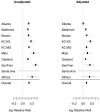Neighborhood racial/ethnic concentration, social disadvantage, and homicide risk: an ecological analysis of 10 U.S. cities
- PMID: 18661242
- PMCID: PMC2527429
- DOI: 10.1007/s11524-008-9302-y
Neighborhood racial/ethnic concentration, social disadvantage, and homicide risk: an ecological analysis of 10 U.S. cities
Abstract
Homicide is one of the leading causes of death among African-American and Hispanic men. We investigated how neighborhood characteristics associated with social disadvantage explain racial/ethnic homicide gaps in 10 U.S. cities. The test hypotheses were that (1) higher concentrations of African-Americans and Hispanics would be associated with higher homicide rates and (2) the relationship between racial/ethnic concentration and homicide would be attenuated after adjusting for neighborhood characteristics (e.g., unemployment, median household income, low educational attainment, and female headship). The test hypotheses were examined using separate Poisson regression models, which adjusted for spatial autocorrelation. Homicide rates were greater in neighborhoods with higher concentrations of African-Americans and Hispanics than in other groups, and the association of neighborhood racial/ethnic concentration with homicide was reduced after adjusting for neighborhood social disadvantage variables, especially percent female head of household and percent persons with less than a high school education. We also found that the relationship between neighborhood racial/ethnic concentration and homicide was explained more by social disadvantage variables in some cities than in others. Based on our findings, policy makers may wish to consider implementation of policies that (1) expand early childhood education programs and higher education opportunities and (2) encourage economic and community development initiatives in socially disadvantaged neighborhoods.
Figures



References
-
- Centers for Disease Control and Prevention. WISQARS Non-fatal Injury Reports. 2004. http://cdc.gov/ncipc/wisqars/. Accessed on October 5, 2007.
-
- Zernike K. Violent crime in cities shows sharp surge. New York Times. March 8, 2007. http://wwwnytimes.com/2007/03/09/us/09crime.html. Accessed on October 12, 2007.
-
- Reiss AJ, Roth JA, eds. Understanding and preventing violence. Panel on the Understanding and Control of Violent Behavior, Committee on Law and Justice, Commission on Behavioral and Social Sciences and Education, National Research Council. Washington, DC: National Academies; 1993.
-
- None
- Sampson RJ, Wilson WJ. Race, crime, and urban inequality. In: Hagan J, Peterson RD, eds. Crime and Inequality. Stanford, CA: Stanford University Press; 1995:37–54.
-
- None
- Wilson WJ. The Truly Disadvantaged: The Inner City, the Underclass, and Public Policy. Chicago, IL: University of Chicago Press; 1987.
Publication types
MeSH terms
Grants and funding
LinkOut - more resources
Full Text Sources

